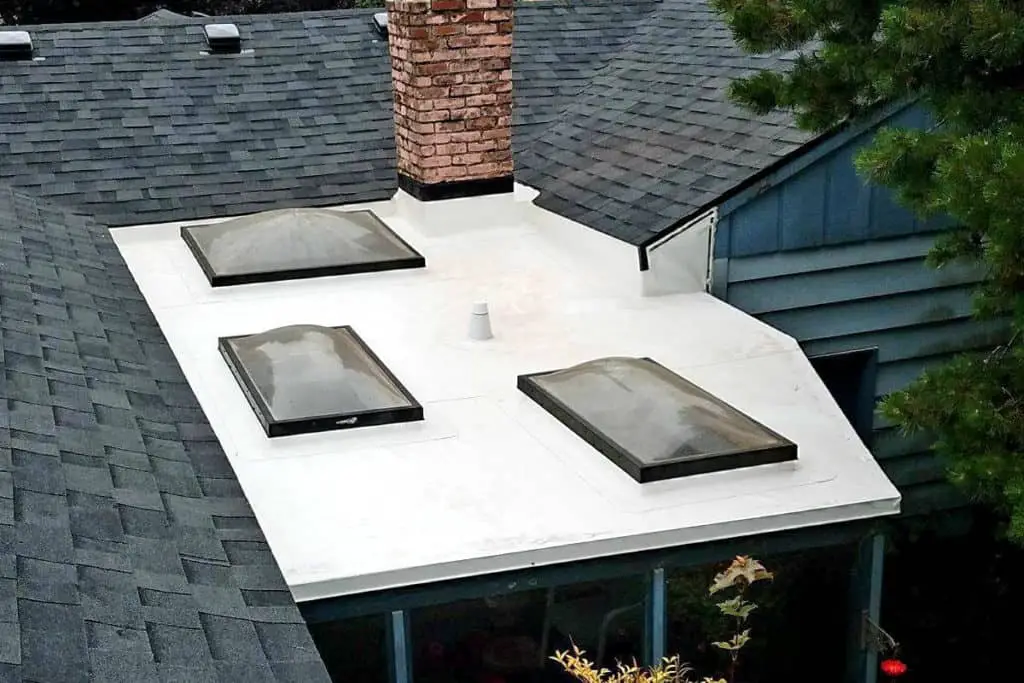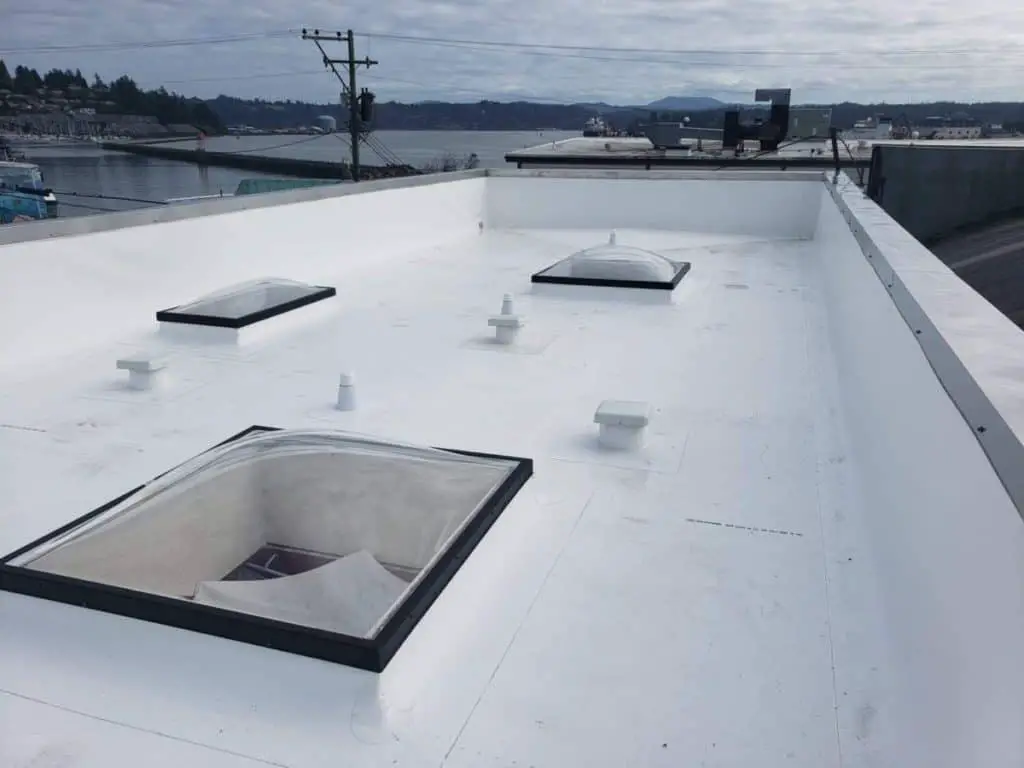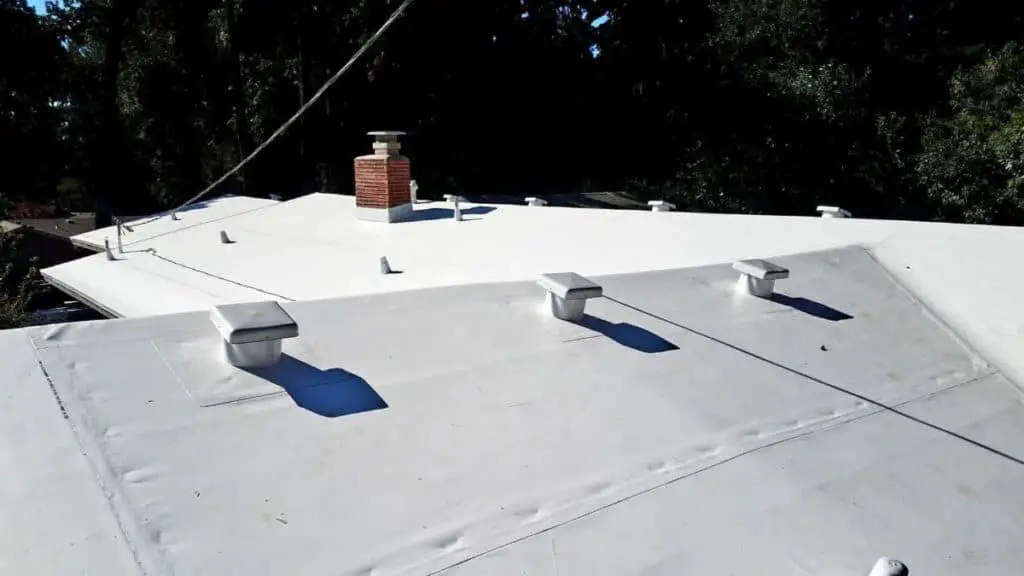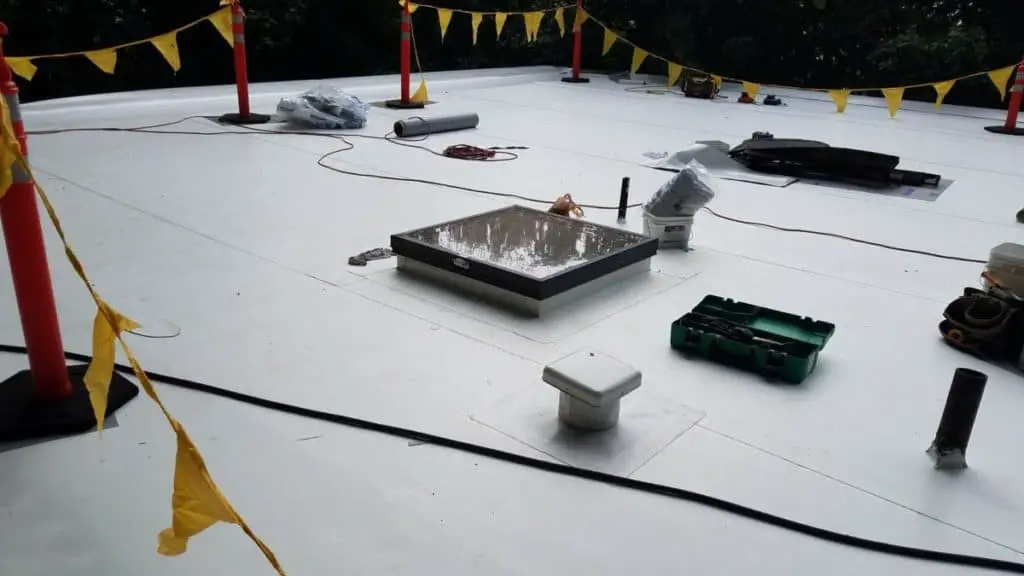
What is PVC roofing?
If you are thinking about replacing your low slope roof PVC is a great option to consider.
PVC stands for Polyvinyl Chloride and is made up of ethylene and chlorine which are derived from processed petroleum or natural gas and salt respectively.
It may be installed mechanically with special screws and plates or fully adhered with a bonding adhesive like a FleeceBack roof system.
Similar to TPO, PVC’s seams are heat welded together using a heat welder (link to amazon).
Worried About Doing the Work Yourself?
I recommend finding a professional roofing contractor through our trusted partner Home Advisor because they allow you to get up to 4 quotes for free. This allows you to compare and choose the best roofing professional for your needs. Check them out by clicking this link.
Pros:

1.Variety of Colors:
PVC can come in a variety of colors ranging anywhere from tans, and grays, to the most commonly used white color.
2.UV Resistance:
PVC is very effective and resisting UV radiation. Its white color also aids in reflecting the sun’s rays. This helps to save you money because it lowers your cooling costs in warm climates. It also helps to reduce the heat island effect which can occur in urban areas.
3.Fire Resistance:
PVC does not only meet the requirements for a Class A fire rating. But it also contains special chemicals that allow it to be a self-extinguishing material. In various tests, PVC has proven to be more fire-resistant than TPO. The video below shows an experiment done to see how TPO and PVC burn.
4. Varying thickness sizes:
Another advantage of PVC is that it comes in different thicknesses. This gives consumers more options. The thicknesses of the PVC can range anywhere from 40 mils to 80 mils.
5. Puncture Resistance:
PVC is very resistant to tears and punctures. It has a Class 4 Hail damage rating which means it withstood the simulated 2-ich sized hail test. This test is usually performed with a 2-inch sized spherical piece of ice or sometimes a metal ball.
6.Chemical Resistance:
PVC does a good job of being resistant to chemicals like oil and grease. Which makes it ideal for fast food restaurants who use a lot of oil and grease to cook their food. Sometimes the grease trap exhaust fan leaks grease onto the roof. They also make grease trap exhaust fan leak containment which helps but isn’t perfect.
7.Price:
PVC is similar in price to other low slope roof options. PVC costs about $75 – $250 per square (excluding installation costs). Which makes it more expensive than EPDM. It can also be less expensive than TPO.
8.Lifespan:
PVC has a life expectancy of about 20 – 30 years which is a pretty normal life expectancy for a roof. That is about the same life expectancy as some common types of asphalt shingles.
9.Welded Seams:
The seams of PVC are welded together using a special heat welder. The sealed seams if properly welded do an excellent job at keeping water out. Heat-welded seams are more effective than other seams that are bonded together using an adhesive tape.
10.Repairs:
It is fairly simple to make repairs to a PVC roof. All you will need is a heat welder and a roller to make most repairs. If you have the tools, you could probably make the repairs on your own. However, it is best to hire a professional if you don’t know what you are doing.
11. Wind Resistance:
PVC holds up well in strong winds. It has a strong wind uplift rating and has been known for withstanding category 3 hurricanes which are wind speeds between 110 mph to about 130 mph.

12.Recyclable:
PVC just like other roofing materials like EPDM and TPO is recyclable. Recycling agencies can turn your old roof into a new roof material, athletic fields, picture frames, shipping materials, and more.
13.Strength:
PVC exceeded the ASTM standard of break strength which is about 200 lbs per square inch. PVC was rated for over 300 lbs per square inch. Which shows it was truly developed with durability in mind.
14.Light Weight:
PVC is a lightweight roofing option. It is a single-ply roof system meaning you don’t need multiple layers of the PVC membrane. PVC weighs at most 51 lbs per square (100 square feet in one square). Which is less than asphalt shingles which weigh about 150 to 240 lbs per square.
15.Versatility:
PVC can be used on both residential and commercial roofing systems. It can not only be used on flat roofs but low sloped roofs as well.
16.Flexibility:
PVC is known to be a bit more flexible than TPO. Some roofing contractors may prefer to use PVC over TPO due to the flexibility characteristics.
17.Temperature:
PVC can be installed during cold temperatures and winter seasons as long as the temperature is above -58° F . After the PVC is attached it is sealed with a heat welder. As long as the heat welder is able to bring the temperature of the PVC membrane to about 1094°F then it will seal properly. The weather just may make the welding process longer.
Cons:

1.Old Roof Removal:
In order to install PVC, it must installed properly on a clean smooth surface. Extra debris can puncture the membrane and cause leaks down the road. Additionally, the old roof must be completely removed before PVC can be installed overtop. This can take some extra time and labor costs.
2.Cold Climates:
PVC does not do well in very cold environments. When it becomes too cold, PVC becomes brittle and can easily crack or shatter if walked on. The temperature range for PVC is -58° F (-50° C) up to 347° F (175° C) anything outside of this temperature range may cause damages the roof rendering it useless.
3.Toxic Chemicals:
PVC can release toxic chemicals during manufacturing and if burned. PVC will release many harmful chemicals one of the most harmful is dioxin which can cause reproductive and developmental problems, change hormones, cause cancer, and damage the immune system.
Alternative Options:
If a PVC roof system doesn’t sound like the right kind of roof for you. There are at least 6 other options available for low slope/flat roofs. Below I have placed a nice little chart with links to other Pros & Cons lists for the other 6 low slope roofing options.
If you are interested in other roofing options I recommend you take a look at this article which I spent several months writing. It is a complete guide where I explain about 17 different types of roofing materials that are used today. You can read the article here.
This chart table shows the 6 other options for low slope roofs.
| Type | Description |
|---|---|
| FleeceBack roof | FleeceBack roof system is a Fleece material made out of polyester that can be added to the underside of EPDM, PVC, or TPO. It is adhered to the surface of the roof using 2-part fast adhesive foam. Click Here to Learn More about the FleeceBack roof system. |
| Built-Up Roof | Built-Up Roof (BUR) is made up of multiple layers alternating between fabric material and bitumen (asphalt). Finally, the last layer is topped with rocks or gravel. Click Here to Learn More about Built-Up Roof. |
| EPDM | EPDM stands for Ethylene Propylene Diene Terpolymer. It’s a rubber-based material. Click Here to Learn More about EPDM. |
| Spray-On Roof (SPF) | Spray-On roof has been around since 1964 and involves spraying layers of polyurethane and silicone. Click Here to Learn More about Spray-On Roof. |
| TPO | TPO stands for Thermoplastic Polyolefin. This is a single-ply flat roof system that the newest of all the flat roof systems. Click Here to Learn More about TPO. |
| Modified Bitumen | Modified Bitumen is a 2-part flat roof system. It was developed in Europe around the 1960s. It comes in two different types. Click Here to Learn More about Modified Bitumen. |
Related Questions:
Is PVC roofing any good? PVC roofing is a good option for those who need a roof that is resistant to animal grease, flexible, resistant to chemicals, and fire-resistant. In the most general sense, I would recommend PVC over EPDM.
What is better TPO or PVC? It depends on what your needs are. TPO is slightly more durable and stronger. But PVC has qualities like better fire resistance, chemical resistance, and flexibility that may make it better suited for specific needs over TPO.
